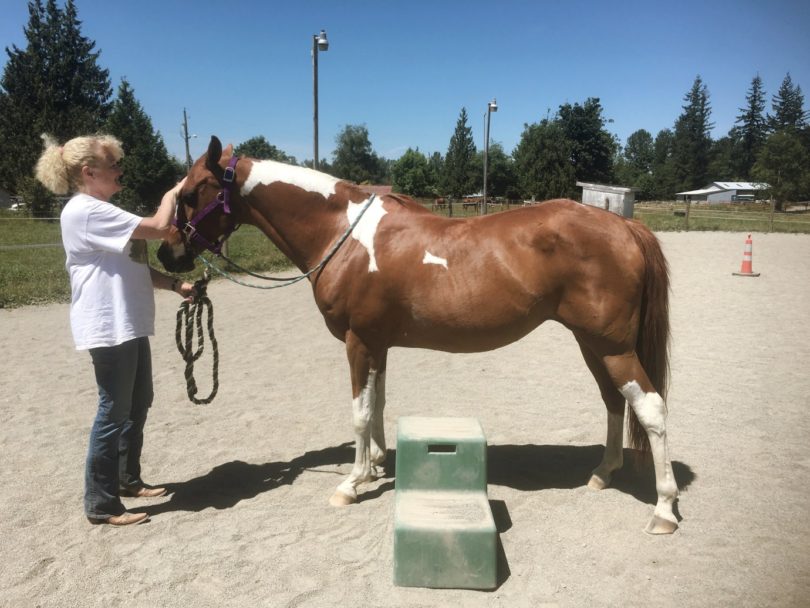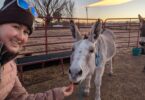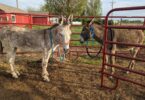Did I Say Bright Green?
Summer is officially upon us. Trail rides aside, we have been having great fun spending the longer hours of the evening training the horses. This week has been a wonderful week of discovery in our sessions with Rose. I knew already that she was unexperienced under saddle, but after further observation, both Sherry and I have
concluded that she is much greener than either of us originally thought.
Be sure to check out her first and second sessions if you are interested in more of her back story.
This realization followed her general tension under saddle, along with confusion about leg aids. And by leg aids, I don’t mean bending or picking up the canter. I mean “Pressure on my sides means I stop and snort, right?” Trying to simply squeeze or tap her forward has been met with the opposite reaction: her head shot up, body got stiff, and ears pinned back. Persisting with another squeeze or bop to her side sometimes brought some swinging teeth.
Discouraged and puzzled, we were hungry for an alternative approach. Neither of us want to continue pushing her farther into misunderstanding and tension. We have Rose’s progress on the lunge line in our favor. Sherry has been working with her consistently on trot-canter transitions, and has even incorporated “hoa” on the lunge line. Read more about that methodology here. Rose has taken so well to her lunge sessions, that it has become a useful segue for her training under saddle.
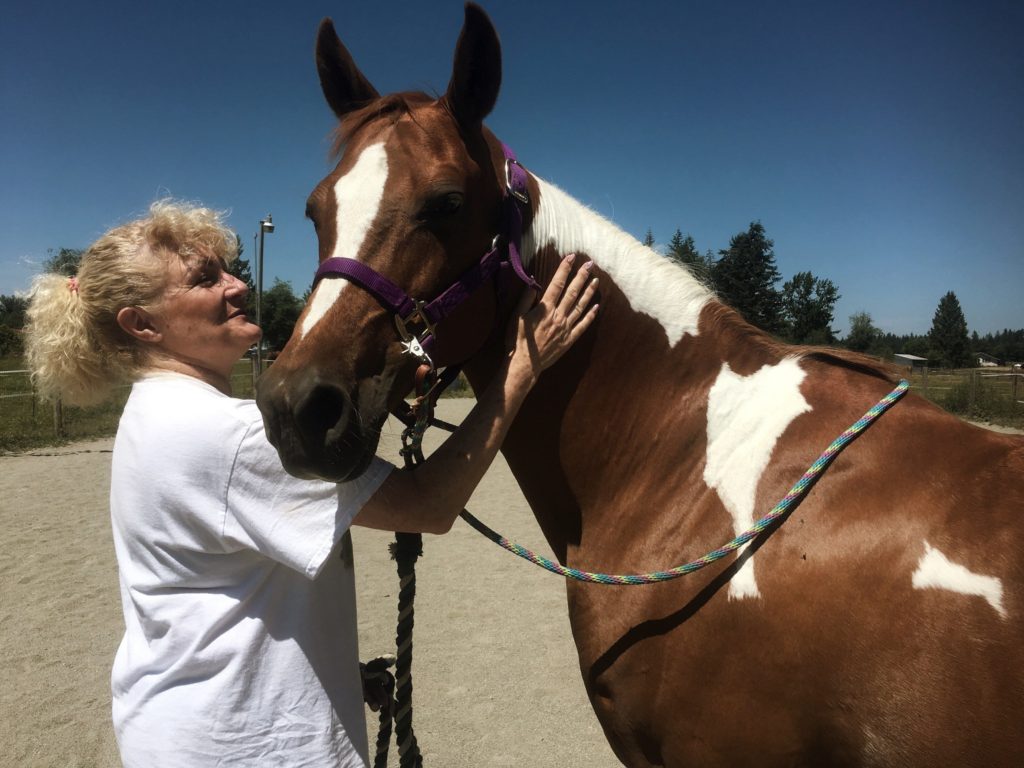
Photo Credit: Lindsey Rains
Or, Should I Say, Under *No* Saddle
A combination of her success on the lunge line, and extreme sensitivity, confusion, and tension under saddle has led to experimentation with the alternative: bareback training. I had heard of others doing it as a supplement to under saddle training, but have never seen it done in person. This is my first time working with a green horse bareback, though I have worked with experienced horses bareback.
My word of caution, even for those who are cowboy enough to just wear hats when riding, is to wear a helmet. Should you work with a green horse, your risk factor is already high. Take away the saddle, and your likelihood for falling off when they spook or get confused is much higher.
 Step One – Mounting Block Desensitization
Step One – Mounting Block Desensitization
Sherry and I kept the halter on and used a lunge line clipped to the bottom and nylon reins clipped to the sides. She held onto the line, and I had the reins for steering once I got on. Sherry led her to the block and showered her with pets and reassurance. I approached the mounting block and spent some time stepping up and down the two steps, petting her on the side closest to me, as well as hanging over her back to pet the opposite side of her body.
As she relaxed, I pulled the mounting block back from her (as a pressure release). Then, I tried dropping the mounting block several times to make sure the sound wouldn’t scare her. Sherry has been doing this desensitization process for months with Rose, so we both expected her to do well. Rose was unfazed and even dozing off—a good sign for us. So, I practiced running up to her, which took her off-guard. But she settled, and was calmer when I did it the second time.
The point was to startle her in a controlled environment to teach her how to handle that situation in the future (for example, when children are around her).
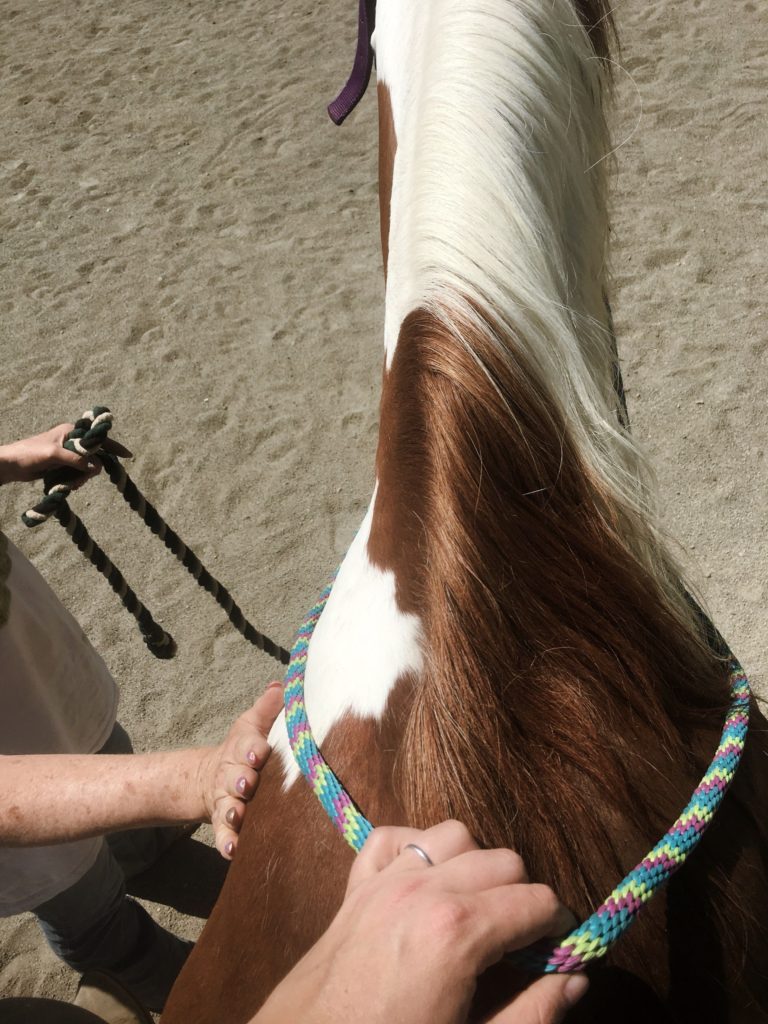
Photo Credit: Lindsey Rains
Step Two – Mount-up Signal and Weight Distribution
After making sure she was relaxed, even with all my shenanigans, it was time to mount up. Remember: this could have been her first time being ridden bareback. Regardless, I had made up in my mind that she was going to love it. I was calm, confident, and eager to see how well she responded. I fixed my frame of mind beforehand, because if I didn’t, she could feel the anxiety in my body all the better once I got on her and had no tack buffer.
I lifted my right leg slowly and rested my knee and calf on her rump. She shifted a little and wiggled her ears around. Once she settled, I did it again. I repeated until she was fully relaxed again. Then I swung my leg slowly over her until it reached all the way over her, but most my weight was still planted on the mounting block. The first time I did this, she walked forward to get away. Knowing she might do this, I slid my leg off before I could get off-balance and fall. Sherry walked her back to the block, and I repeated.
This time, she was settled and stood while I hung my right leg over her body. I pet her and praised her, and she dropped her head, all sleepy again. Once I was ready to really get on her, I rubbed her neck under a chunk of her mane. I am hoping to develop this as a signal to prepare her for someone mounting her, at least bareback. I swung my leg over again, still planted in my left foot. Seeing she was still calm, I slid my weight into my right leg and rested completely on her.
She moved a little, then settled again. Sweet victory!
By comparison, when a rider mounts her with her saddle on, she shoots her head straight up and starts to move right away, even with all the desensitization work that we have done with her. Now with just a rider on her back, Rose was calm.
I practiced mounting and dismounting at the block. Then I dismounted the opposite side, just in case future riders decide to dismount on her other side. She got to the point where I could mount without her moving, even when I began to get on faster. When I was confident that she was comfortable with this process, we moved forward.

Photo Credit: Lindsey Rains
Step Three – Leading
Sherry had been holding the lunge line the whole time. We determined to work in tandem with her signals, which for now is just “walk” and “hoa.” I squeezed Rose forward, and this time, she moved forward without protest! No sticking her head up, no biting, no tension. Of course, this was largely attributed to Sherry leading her from the ground, but that was the point.
We are taking Rose’s strengths and comfort zones and redistributing them to being associated with a rider on her back. We don’t want a horse who is amazing on the ground and on the lunge line, then sour under saddle. Furthermore, we don’t want her to experience a rider as “the bad thing.”
So, when she did well one lap around the arena, I hopped off, and Sherry walked her by herself around the arena without me on her back. This was to reset her mind and to encourage her that she was doing well. I then got back on her, and we practiced “hoa” and “walk” as voice commands and with leg and seat cues. I was extra conscientious about sending all the appropriate signals for the “hoa” before tugging on her reins.
She got to the point where she hesitated when she felt my hip stop moving and my core muscles tightening up. Then I would relax my muscles, squeeze her a little with my leg, and she would walk on calmly. Another crucial aspect of my seat was keeping my hips mobile when she was moving and I wasn’t asking for a halt. I wanted her to feel that the situation was comfortable and safe, and that her movement was met with the least tension possible.
Step Four – Moving Away from the Leader
This was undoubtedly my favorite part of the whole experience. We worked with Rose a couple of times bareback before we experimented with moving away from the ground leader. Sherry continued to lead her with a lunge line (which we used because of its length), and we chose a point in the lesson where we would start to move her away from Sherry.
Sherry gave some slack on the line, and I squeezed her just a little bit with my inside leg. Rose moved away from the pressure. I did it again, and when she wanted to get back next to Sherry’s side, I would tug her a bit with the outside rein. The process was uncomplicated. And remember, all this is done bitless in addition to bareback. We want to start her sensitive and keep her sensitive.
After another session of repeating this process, we got her walking in a big, half-arena circle around Sherry. She reversed direction and completed several “hoa” and “walk” cues without the help of Sherry’s signals.
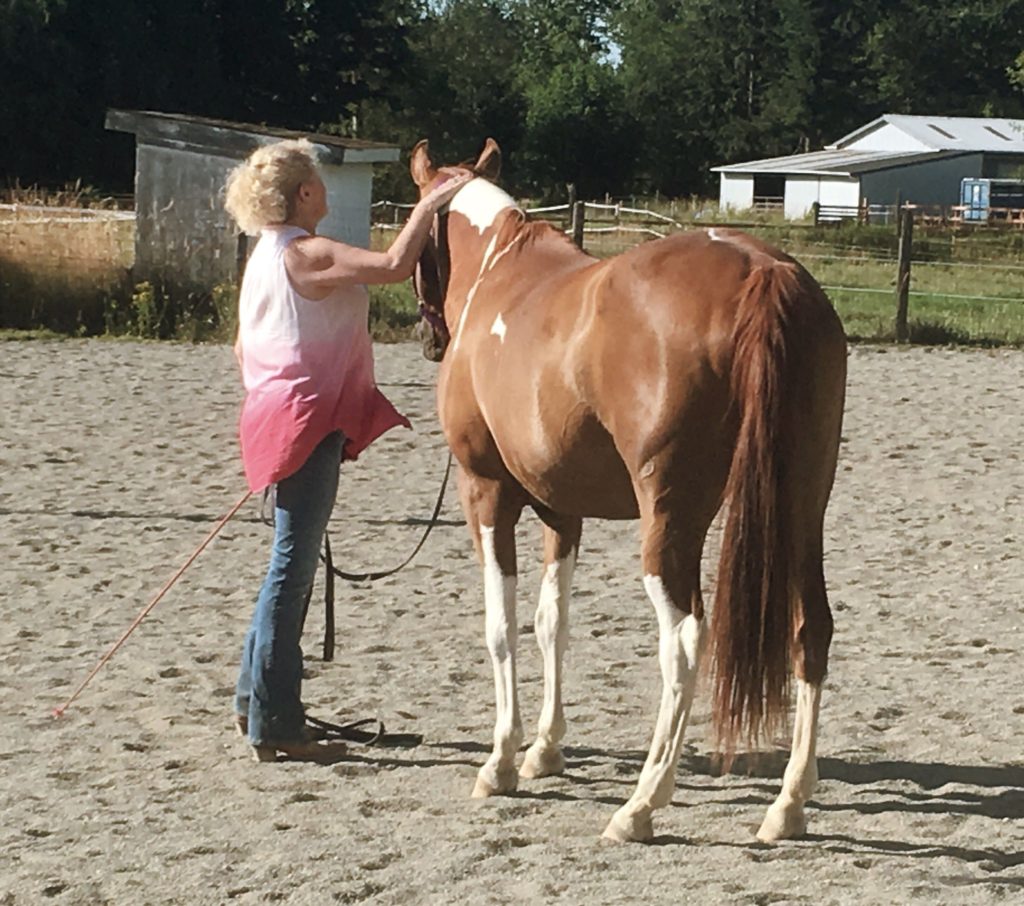
Photo Credit: Lindsey Rains
Going Forward
If we were to look at these sessions in the light of a fully-trained horse, they might be a bit discouraging. Walking on a lunge line is no big trick. For Rose and where she had come from, however, this was a major accomplishment. Within just a few short sessions, she has gone from tension and confusion carrying a rider, to relaxed and consistently learning.
By utilizing the lunge line (where she is already confident) as a platform for transitioning into riding, we are cutting out a lot of battles in her finishing work.
From here, the plan is to gain her confidence with a rider and the aids, then reincorporate the saddle little by little. Considering her sensitivity and intuition, she has the potential to be a very skilled horse. For now, I am grateful for the small accomplishments we see every week with her, and for the extra hours the summer allots us to work with our horses.
Frequently Asked Questions
Is bareback horse riding safe?
Bareback horse riding can be safe depending on many different variables. The rider’s physical fitness and experience can be crucial for them to stay balanced without a saddle. The horse’s experience, conformation, and body condition can also make a bareback ride either easier or more difficult to manage.
Bareback horse riding may not be safe if you are on a nervous, spooky, or hot horse or if you are in dangerous terrain like mountains. If you are just starting out bareback riding, it is a good idea to begin slowly and steadily in a safe place, like a round pen or arena. You also should have a buddy with you in case of emergency!
Once you are comfortable walking you can start learning trotting and then cantering. Some people even do bareback jumping, but you need to be in excellent physical condition and have a steady seat.
What is a bareback pad?
A bareback pad is a somewhat cushioned pad, often roughly the shape of a saddle, that has a girth. Many bareback pads have a grab strap in the front for emergencies while others have the option of stirrups.
Riders will sometimes opt for a bareback pad because it can help cushion your seat and your horse’s back from pokey bones, provide a little more grip, and help with balance without losing that bareback feel.
There are a wide variety of pads out there with different shapes or materials, but it is up to the rider to choose which one they want. Some bareback pads offer more cushion, more grip, more add-ons, or have a more anatomical shape.
Should you use a pad for bareback riding?
You should use a bareback pad for riding if your butt is a bit boney and your horse needs some protection, if your horse has a boney back and YOU need a little protection, or if you just want to ride “bareback,” but need more grip, cushion, or security to feel comfortable.
A bareback pad can also be useful to keep your riding pants from collecting sweat and dirt from your horse’s back! Anyone who had jumped on for a quick bareback ride has probably dealt with a dirty, and possibly damp, butt and a comical “clean spot” on their horse’s back.
Chief Rookie Aside: I use the Best Friend Bareback Pad, and I love how the cushioning keeps my seat in the proper position. Plus it has a grab strap that has come in handy.
If your horse is a little plump then a bareback pad might be a good choice to keep you from slipping off as easily. Trying to grip a jiggling, perfectly round horse can be borderline impossible! Until he loses some weight you may consider use of a bareback pad for added safety.
How do you get on a horse without a saddle?
Most people use a tall mounting block to get up high enough to swing a leg over the horse’s back, but even if you have one it might be a little awkward the first time. Since you don’t have a stirrup to assist, you need to lean more of your body weight over the horse to swing your leg over. Grab a good hold of mane if you need something to grip.
Extra talented people (with extra chill horses) can jump up and over from the ground, but don’t try this unless you’re experienced and know your horse very well.
What are some benefits of horses riding without a saddle?
There are many benefits to riding a horse without a saddle. One of the biggest ones is that it greatly improves your seat and balance. Without a saddle and stirrups, you have to use your core strength and correct seat to keep from sliding off. You have to be very connected to your horse’s movements which in turn makes you a lot more “in tune” with your horse.
Bareback riding may also result in fewer pressure points on the horse’s back than riding with a saddle and *might* be more comfortable for the horse. However, if you are super boney or if the horse has a sore spot right where your seat bones touch, they may experience pain or discomfort. Horses can also take a bit to get used to the sensation of a bareback rider, and they sometimes feel nervous or worried if their rider feels unbalanced. Once you’re both used to the experience, bareback riding can be a comfortable and pleasant experience for both parties!
P.S. Enjoy this article? Trot on over to:
- 32 Things you can do today to calm your riding nerves forever
- Scared to ride your horse? Get your mojo back
- How can I calm my nerves before horse riding?
- What are some ways to gain confidence riding horses
- Safe or sorry: how often to replace horseback riding helmets

